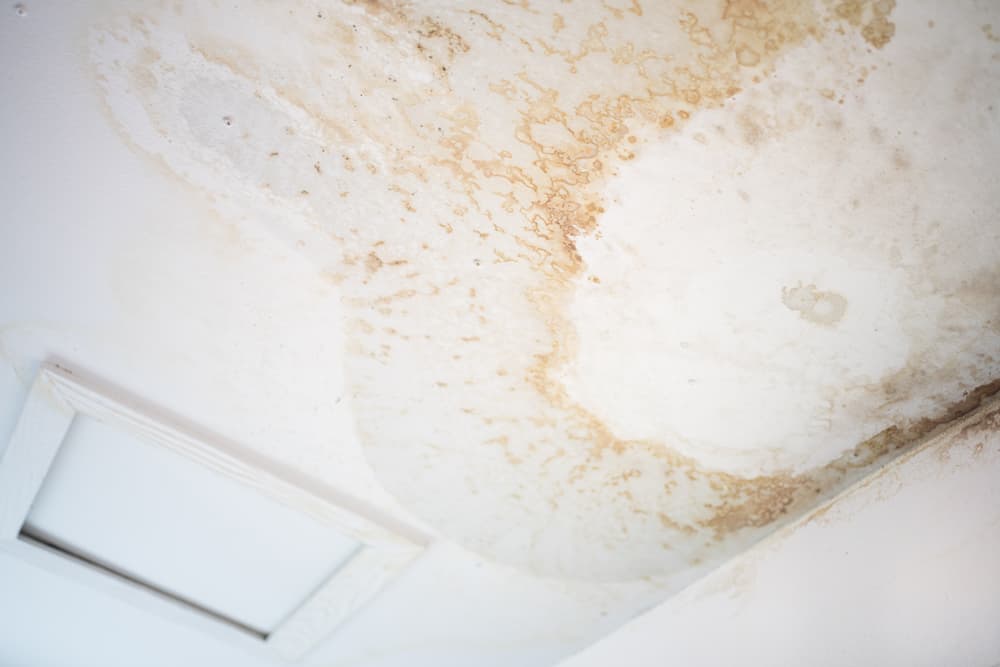Finding a brown spot on your ceiling wall is concerning. If it remains, or continues to grow, it is only a matter of time before the water breaks through the ceiling and has you scrambling for pots and buckets to contain the leak. It’s annoying and scary to know your roof could be compromised and would need immediate repair to prevent cosmetic and structural damage.
National Roofing cares for your roof health and wants you to know some common roof leak causes.
4 Common Causes of Roof Leaks
Here are the common sources for leaks to look out for.
Poor maintenance of Roof or Rooftop Mechanical Units
Leaks at the roof can be caused by failures at rooftop equipment such as swamp coolers and HVAC units, or from carelessness of workers maintaining that equipment. Leaks can occur inside ductwork and have nothing to do with the roof membrane itself. It is important to check mechanical equipment as a possible source of water intrusion as well as reviewing the condition of the entire roof for signs of premature wear and tear. During winter, accumulated snow and ice can cause cracks in the roof membrane and allow water to seep into the ceiling cavity.
On pitched roofs, ice dams are created when snow above heated spaces melts and re-freezes at unheated overhangs. The weight of ice at these dams can lead to collapsed gutters, loose shingles, damaged flashing, degraded underlayment and even structural damage. Ice damming can be prevented by proper roof design, but if you already have them, we can minimize their destructive potential by rebuilding the eave to include more robust underlayment, gutter supports and even by adding heat trace (electrical wire designed to melt built-up ice) in extreme cases.
Improperly installed skylights
Over the years, skylights have gotten a bad rap. This is in part because skylights can leak from the curb that is placed on the roof for the skylight to sit on, or from the skylight assembly itself. The key is to purchase a quality skylight and have it properly installed. Manufacturers of skylights and curbs provide clear instructions on where the roof flashing should terminate, how high the curb should be above the roof line (8” minimum), when to place diverters at the high side of the curb (when the curb is 30” wide or more) and how to set the skylight on top of the curb for a proper seal. When skylights are set over heated spaces, skylights should have at least two layers of translucent material, and those layers need to be properly ventilated to prevent condensation build-up. Some skylights have 10-year no-leak guarantees and can serve you for decades without problems.
Improper Fastening
At shingled roofs, it is important to use the right type of nail, the proper number of nails at each shingle, and place the nail in the right location above the adhesive strip. A properly driven nail sits tight to the surface of the shingle and holds securely to the roof deck. Shingles can pop off or ‘fatigue’ from movement during wind if not fastened properly, and water can get into the nail holes if they are set improperly.
At single ply membrane roofs (TPO, PVC, EPDM), fasteners are placed along the seams and at the roof to wall transition. It is important to provide additional fasteners at the roof edges where wind forces are the greatest, and to properly lap and weld the seams to protect the lines of fasteners.
Our roofing experts carefully follow the manufacturer’s requirements for initial installation as well as for repairs at all types of roofing.
Damaged vent and pipe booting
Boots’ are the flashing used to seal the bottom of pipes that penetrate through the roof membrane. These are primarily pipes and vents that provide gas, electricity or ventilation to the interior of the building. Using the proper boot material (compatible to the roof membrane) is crucial when installing field fabricated or pre-manufactured boots. Additionally, setting the top of the boot at the proper height above the roof line (8” minimum) and following other manufacturer’s instructions for installation will extend both the life of the boot and the entire roof assembly. Regular inspection and maintenance is especially important at curbs, wall flashings and pipe boots since these are the most common points of roof failure.
Do you need to hire a roofing professional to repair your roof?
While you might be tempted to handle some of these repairs yourself, it is not recommended. Aside from risking serious injury, one mistake on the repair could easily make the situation worse. At National Roofing, we have experience spotting potential sources of roof leaks and the expertise to execute long term repair solutions. While we are confident in our fixes, the best defense is offense, in this case, regular roof maintenance.
When should you call a roofing professional to repair your roof?
Call a professional roofer for repairs immediately if you spot a roof leak or see damaged or missing shingles. It’s in your best interest to work fast to prevent structural damage that could cost you a fortune more.
Schedule a roof walk with National Roofing
f you notice any of these signs, you have a roof leak in your hands and need a professional to avoid extensive water damage. We’ve been around for over four decades serving the Albuquerque area, and our roofers are knowledgeable, experienced, trustworthy, and have a great work ethic.
Although we offer emergency service, it is preferable to be proactive! Request a roof walk today for excellent service.
Featured Image Credit: Hanger/Shutterstock

